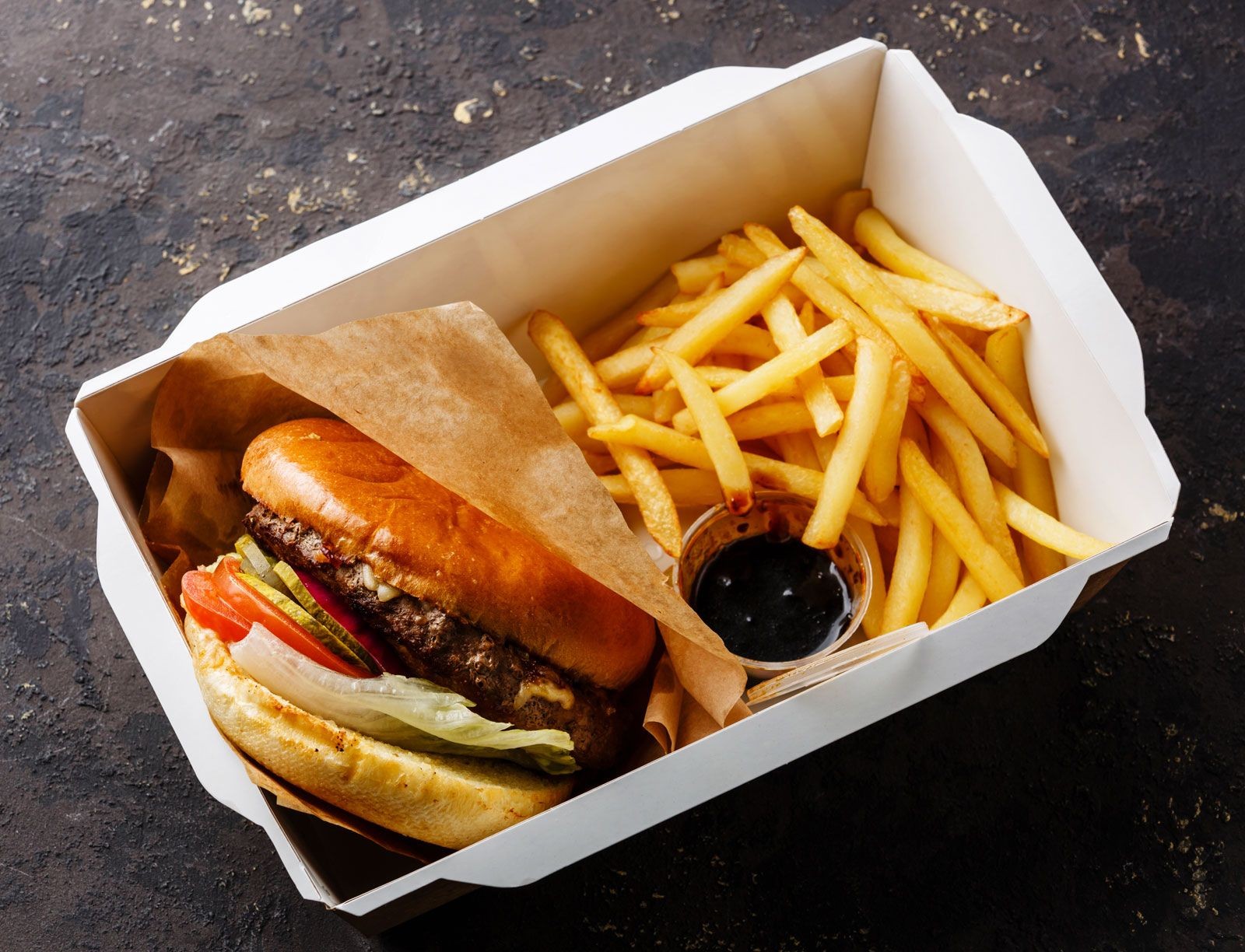Fast food is a mass-produced food designed for quick preparation and distribution, typically sold in restaurants, concession stands, and convenience stores. It’s often associated with well-known chain restaurants such as McDonald’s, Burger King, and Taco Bell, prioritizing convenience and speed through take-out and drive-through services. Common examples include hamburgers, hot dogs, french fries, pizza, tacos, burritos, salads, and sandwiches.
 A classic fast food combination: hamburger and french fries served in a paper box.
A classic fast food combination: hamburger and french fries served in a paper box.
The History of Fast Food
The concept of easily accessible, ready-to-eat meals stretches back thousands of years. Evidence suggests that on-the-go eating existed as early as Pompeii before the eruption of Mount Vesuvius in 79 CE. In the early 20th century, self-service establishments like Automats and “smash-and-grabs” gained popularity with time-conscious customers looking for a quick bite.
The first White Castle, often considered the original American fast-food chain, opened in Wichita, Kansas, in 1921. With its five-cent burgers, White Castle pioneered the assembly line model, providing efficient service and consistent products, laying the groundwork for future fast-food enterprises.
Post-War Boom and the Drive-Through Revolution
The fast-food industry experienced significant growth after World War II, coinciding with the rise of suburbia, interstate highways, and car-dependent infrastructure. Drive-through restaurants evolved from the drive-in model popular in the decades preceding the war. Drive-throughs required fewer employees and were financially more appealing to fast-food businesses, appealing to both travelers and those seeking a swift meal. In-N-Out Burger, a California-based chain, is typically credited with introducing the modern drive-through, complete with two-way speakers, in 1948.
The latter half of the 20th century saw rapid expansion in the fast-food sector. By the early 21st century, the United States alone housed nearly 200,000 fast-food restaurants, with corporations like McDonald’s, Subway, and Starbucks boasting thousands of locations worldwide. In 2021, American fast-food restaurants generated over $250 billion in revenue.
Technological Advancements in Fast Food
Technological advancements have greatly enhanced the convenience and efficiency of the fast-food experience. Self-ordering kiosks allow customers to place and pay for their orders on a screen, boosting sales and reducing labor requirements. Third-party delivery services such as Uber Eats, Grubhub, and DoorDash offer unparalleled convenience, even beyond the drive-through.
Criticism and Response to Fast Food
The rapid expansion of the fast-food industry has had significant repercussions. McDonald’s has become one of the world’s largest buyers of beef and potatoes, while KFC is frequently cited as the world’s largest purchaser of chicken. This high demand has stimulated industrial livestock production, often criticized as “factory farming,” considered inhumane and environmentally unsustainable. The fast-food industry is often associated with a substantial carbon footprint. Some companies have responded with initiatives aimed at reducing emissions in their restaurants and throughout their supply chains.
Fast Food and Food Deserts
After saturating suburban areas, fast-food companies shifted their focus to urban centers. Fast-food restaurants now proliferate in cities and are seen as contributing to “food deserts” in low-income urban neighborhoods with limited access to nutritious food. Convenience stores selling prepared fast foods like sandwiches, pizza, and hot dogs are also prevalent in these areas. As reliance on fast food is linked to increased risks of heart disease, diabetes, and other health issues, residents of food deserts are disproportionately affected.
Health Implications and Public Awareness
Fast food is strongly associated with rising obesity rates, particularly in the United States. Morgan Spurlock’s 2004 documentary, Super Size Me, highlighted the adverse effects of fast food on the human body. Spurlock documented a month during which he exclusively consumed McDonald’s food. By the end of the experiment, he had gained over 20 pounds and experienced a deterioration in his health, shocking both himself and his doctors. The film served as a wake-up call for the public and health professionals, raising awareness of the negative health consequences of fast food consumption. As a result, many chains began to eliminate trans fats and introduce healthier options such as salads, low-fat milk, and fresh fruit.
Labor Practices and Ethical Concerns
Fast-food corporations have faced criticism regarding their labor practices. Many workers earn low wages and receive limited benefits, including health insurance. This leads to public assistance programs subsidizing fast-food chains as employees often rely on these programs. Furthermore, some cite hazardous working conditions that can lead to injuries, while unionization efforts often meet strong resistance.
Rebranding and Shifting Perceptions
Recognizing the negative connotations of the term “fast food,” various chains have attempted to rebrand their services. Arby’s adopted the descriptor “Fast Crafted” in the mid-2010s, and Dairy Queen unveiled the slogan “Fan Food, Not Fast Food” around the same time. The industry itself often uses the term “quick-service restaurant,” or QSR.
The Future of Fast Food
The fast-food industry continues to evolve, with a focus on convenience, technology, and addressing health and environmental concerns. Innovations in food preparation, delivery services, and menu options will likely shape the future of fast food, aiming to balance speed and affordability with nutrition and sustainability. The definition of “What Is Fast Food” may continue to shift as the industry adapts to changing consumer preferences and societal demands.
